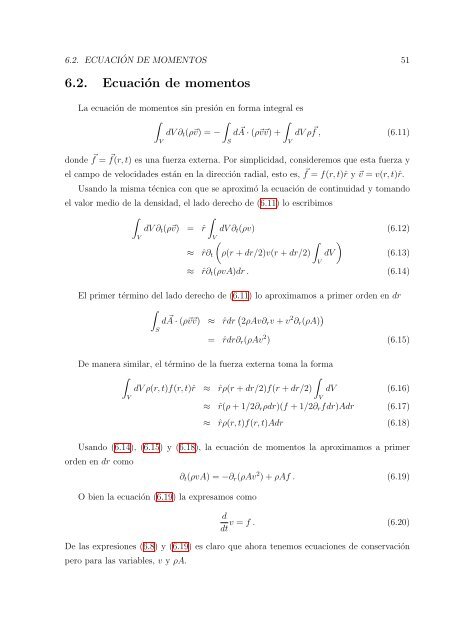Formacion de estructura con campos escalares: la ... - Cinvestav
Formacion de estructura con campos escalares: la ... - Cinvestav
Formacion de estructura con campos escalares: la ... - Cinvestav
- No tags were found...
You also want an ePaper? Increase the reach of your titles
YUMPU automatically turns print PDFs into web optimized ePapers that Google loves.
6.2.ECUACIÓN DE MOMENTOS 516.2. Ecuación <strong>de</strong> momentosLa ecuación <strong>de</strong> momentos sin presión en forma integral es∫∫∫dV ∂ t (ρ⃗v) = − dA ⃗ · (ρ⃗v⃗v) + dV ρf ⃗ , (6.11)VSdon<strong>de</strong> ⃗ f = ⃗ f(r, t) es una fuerza externa. Por simplicidad, <strong>con</strong>si<strong>de</strong>remos que esta fuerza yel campo <strong>de</strong> velocida<strong>de</strong>s están en <strong>la</strong> dirección radial, esto es, ⃗ f = f(r, t)ˆr y ⃗v = v(r, t)ˆr.Usando <strong>la</strong> misma técnica <strong>con</strong> que se aproximó <strong>la</strong> ecuación <strong>de</strong> <strong>con</strong>tinuidad y tomandoel valor medio <strong>de</strong> <strong>la</strong> <strong>de</strong>nsidad, el <strong>la</strong>do <strong>de</strong>recho <strong>de</strong> (6.11) lo escribimos∫∫dV ∂ t (ρ⃗v) = ˆr dV ∂ t (ρv) (6.12)VV∫ )≈ ˆr∂ t(ρ(r + dr/2)v(r + dr/2) dV(6.13)V≈ ˆr∂ t (ρvA)dr . (6.14)El primer término <strong>de</strong>l <strong>la</strong>do <strong>de</strong>recho <strong>de</strong> (6.11) lo aproximamos a primer or<strong>de</strong>n en dr∫dA ⃗ · (ρ⃗v⃗v) ≈ ˆrdr ( 2ρAv∂ r v + v 2 ∂ r (ρA) )S= ˆrdr∂ r (ρAv 2 ) (6.15)De manera simi<strong>la</strong>r, el término <strong>de</strong> <strong>la</strong> fuerza externa toma <strong>la</strong> forma∫∫dV ρ(r, t)f(r, t)ˆr ≈ ˆrρ(r + dr/2)f(r + dr/2) dV (6.16)V≈ ˆr(ρ + 1/2∂ r ρdr)(f + 1/2∂ r fdr)Adr (6.17)≈ ˆrρ(r, t)f(r, t)Adr (6.18)Usando (6.14), (6.15) y (6.18), <strong>la</strong> ecuación <strong>de</strong> momentos <strong>la</strong> aproximamos a primeror<strong>de</strong>n en dr comoO bien <strong>la</strong> ecuación (6.19) <strong>la</strong> expresamos como∂ t (ρvA) = −∂ r (ρAv 2 ) + ρAf . (6.19)ddt v = f . (6.20)De <strong>la</strong>s expresiones (6.8) y (6.19) es c<strong>la</strong>ro que ahora tenemos ecuaciones <strong>de</strong> <strong>con</strong>servaciónpero para <strong>la</strong>s variables, v y ρA.VV
















